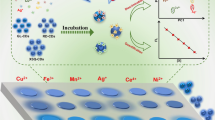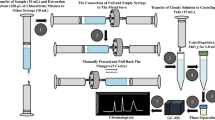Abstract
As nanoscale materials have gained in economic importance over recent years, concerns about accumulation in the environment and, consequently, analysis of nanoparticles in biological material have increasingly become the focus of scientific research. A nanomaterial used in a wide range of food, consumer and household products is titanium dioxide (nTiO2). Monitoring of nTiO2 via determination of elemental titanium (Ti) can be very challenging because of a variety of possible interferences. This work describes problems during the development of a quantification method for titanium dioxide (TiO2) using inductively coupled plasma-quadrupole mass spectrometry (ICP-qMS). To evaluate the analytical method, certified vegetable reference material NCS DC 73349 was used. Interestingly, measurements of NCS DC 73349 seemed to result in acceptable recovery values—however, this was without considering interferences or conceivable differences in the natural isotopic abundance of the certified titanium calibration solution and NCS DC 73349. Actually, recoveries were lower than initially assumed. The potential interferences causing augmented recovery could be attributed to the presence of the elements sulfur (S) and phosphorus (P), which were able to form oxide ions and nitrogen-interfering species. The effect of such interfering cluster ions could be prevented by dry ashing as a sample preparation step, to evaporate S and P, before digestion with aqua regia in a high-pressure asher (HPA). Final practicability of the analysis method was proved by monitoring the uptake of nTiO2 by the microalgae Scenedesmus acutus in an environmental exposure study.

ᅟ
Similar content being viewed by others
References
Steinbach C, Förster A Knowledge base nanomaterials, DaNa, Frankfurt am Main. URL: http://www.nanoobjects.info/cms/lang/en/Wissensbasis/Titandioxid
Landsiedel R, Ma-Hock L, Kroll A, Hahn D, Schnekenburger J, Wiench K, Wohlleben W (2010) Testing metal-oxide nanomaterials for human safety. Adv Mater 22:2601–2627
Weir A, Westerhoff P, Fabricius L, Hristovski K, Goetz N (2012) Titanium dioxide nanoparticles in food and personal care products. Environ Sci Technol 46:2242–2250
Kiser MA, Westerhoff P, Benn T, Wang Y, Pérez-Rivera J, Hristovski K (2009) Titanium nanomaterial removal and release from wastewater treatment plants. Environ Sci Technol 43:6757–6763
Westerhoff P, Song G, Hristovski K, Kiser MA (2011) Occurrence and removal of titanium at full scale wastewater treatment plants: implications for TiO2 nanomaterials. J Environ Monit 13:1195–1203
Menard A, Drobne D, Jemec A (2011) Ecotoxicity of nanosized TiO2. Review of in vivo data. Environ Pollut 159:677–684
Luque-Garcia JL, Sanchez-Díaz R, Lopez-Heras I, Martin P, Camara C (2013) Bioanalytical strategies for in-vitro and in-vivo evaluation of the toxicity induced by metallic nanoparticles. Trends Anal Chem 43:254–268
Navarro E, Baun A, Behra R, Hartmann NB, Filser J, Miao A-J, Quigg A, Santschi PH, Sigg L (2008) Environmental behavior and ecotoxicity of engineered nanoparticles to algae, plants and fungi. Ecotoxicology 17:372–386
Lorenz C, Tiede K, Tear S, Boxall A, von Goetz N, Hungerbühler K (2010) Imaging and characterization of engineered nanoparticles in suncreens by electron microscopy, under wet and dry conditions. Int J Occup Environ Health 16:406–428
Johnston BD, Scown TM, Moger J, Cumberland SA, Baalousha M, Linge K, van Aerle R, Jarvis K, Lead JR, Tyler CR (2010) Bioavailability of nanoscale metal oxides TiO2, CeO2 and ZnO to fish. Environ Sci Technol 44:1144–1151
Warheit DB, Sayes CM, Reed KL, Swain KA (2008) Health effects related to nanoparticle exposures: Enivronmetal, health and safety considerations for assessing hazards and risks. Pharmacol Therapeut 120:35–42
Foltête A-S, Masfaraud J-F, Bigorgne E, Nahmani J, Chaurand P, Botta C, Labille J, Rose J, Férard J-F, Cotelle S (2011) Environmental impact of sunscreen nanomaterials: ecotoxicity and genotoxicity of altered TiO2 nanocomposites on Vicia faba. Environ Pollut 159:2515–2522
Lomer MCE, Thompson RPH, Commisso J, Keen CL, Powell JJ (2000) Determination of titanium dioxide in foods using inductively coupled plasma optical emission spectrometry. Analyst 125:2339–2343
Packer AP, Larivière D, Li C, Chen M, Fawcett A, Nielsen K, Mattson K, Chatt A, Scriver C, Erhardt LS (2007) Validation of an inductively coupled plasma mass spectrometry (ICP-MS) method for the determination of cerium, strontium, and titanium in ceramic materials used in radiological dispersal devices (RDDs). Anal Chim Acta 588:166–172
Umysová D, Vítová M, Doušková I, Bišová K, Hlavová M, Čížková M, Machát J, Doucha J, Zachleder V (2009) Bioaccumulation and toxicity of selenium compounds in the green alga Scenedesmus quadricauda. BMC Plant Biol 9:58
Yu L, Koirtyohann SR, Rueppel ML, Skipor AK, Jacobs JJ (1997) Simultaneous determination of aluminium, titanium and vanadium in serum by electrothermal vaporization-inductively coupled plasma mass spectrometry. J Anal At Spectrom 12:69–74
Organisation for Economic Cooperation and Development (OECD) (2011) Guidelines for the testing of chemicals. Freshwater Alga and Cyanobacteria, Growth Inhibition Test (Guideline 201, Annex 5 corrected: 28 July 2011). OECD, Paris
Organisation for Economic Cooperation and Development (OECD) (2008) Guidelines for the testing of chemicals. Daphnia magna reproduction test (Guideline 211, adopted 3st October 2008). OECD, Paris
DIN 32645 (2008) Chemical analysis - Decision limit, detection limit and determination limit under repeatability conditions - Terms, methods, evaluation. Deutsches Institut für Normung. Beuth Verlag, Berlin
Berglund M, Wieser ME (2011) Isotopic compositions of the elements 2009 (IUPAC Technical Report). Pure Appl Chem 83:397–410
Vaughan M-A, Baines AD, Templeton DM (1991) Multielement analysis of biological samples by inductively coupled plasma-mass spectrometry. II. Rapid survey method for profiling trace elements in body fluids. Clin Chem 37:210–215
Luck J, Siewers U (1988) Progress in analytical application of an inductively coupled plasma/mass spectrometer system. Fresenius’ Z Anal Chem 331:129–132
Reed NM, Cairns RO, Hutton RC (1994) Characterization of polyatomic ion interferences in inductively coupled plasma mass spectrometry using a high resolution mass spectrometer. J Anal At Spectrom 9:881–896
Marshall J, Franks J (1990) Multielement analysis and reduction of spectral interferences using electrothermal vaporization inductively coupled plasma-mass spectrometry. At Spectrosc 11:177–186
Nonose N, Ohata M, Narukawa T, Hioki A, Chiba K (2009) Removal of isobaric interferences in isotope dilution analysis of vanadium in silicon nitride fine ceramics powder by DRC-ICP-MS. J Anal At Spectrom 24:310–319
Kylin A (1964) The influence of phosphate nutrition on growth and sulfur metabolism of Scenedesmus. Physiol Plant 17:384–402
Acknowledgments
We would like to thank Evonik Industries for providing Aeroxide TiO2 P25 and the OECD for participation in the OECD sponsorship programme.
Author information
Authors and Affiliations
Corresponding author
Rights and permissions
About this article
Cite this article
Potouridis, T., Völker, J., Alsenz, H. et al. Using ICP-qMS to trace the uptake of nanoscale titanium dioxide by microalgae–potential disadvantages of vegetable reference material. Anal Bioanal Chem 406, 2495–2502 (2014). https://doi.org/10.1007/s00216-014-7666-2
Received:
Revised:
Accepted:
Published:
Issue Date:
DOI: https://doi.org/10.1007/s00216-014-7666-2




